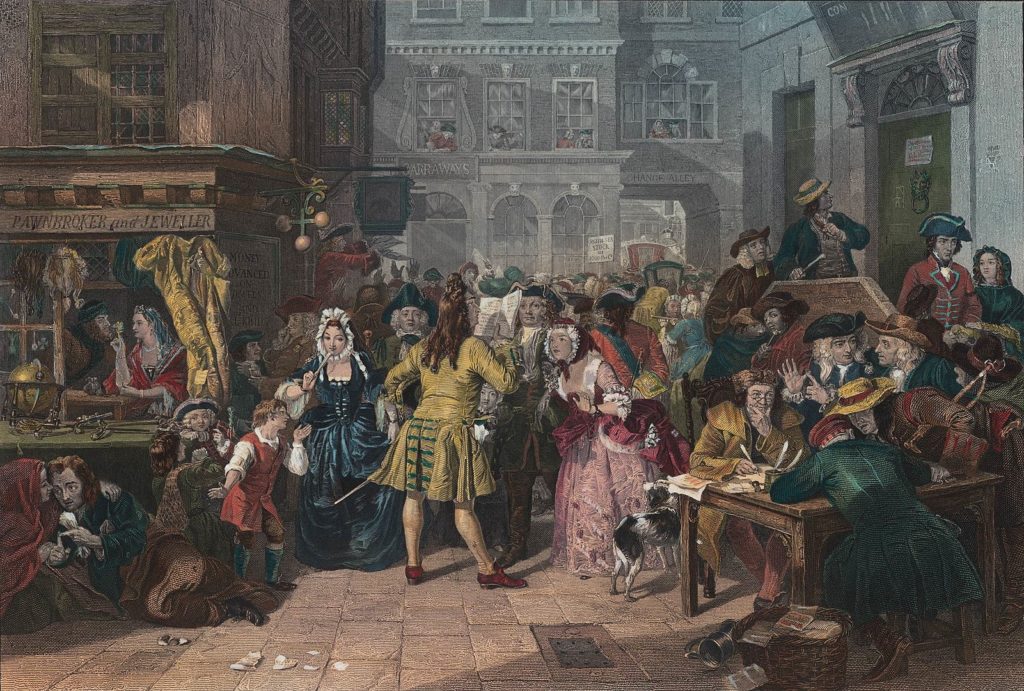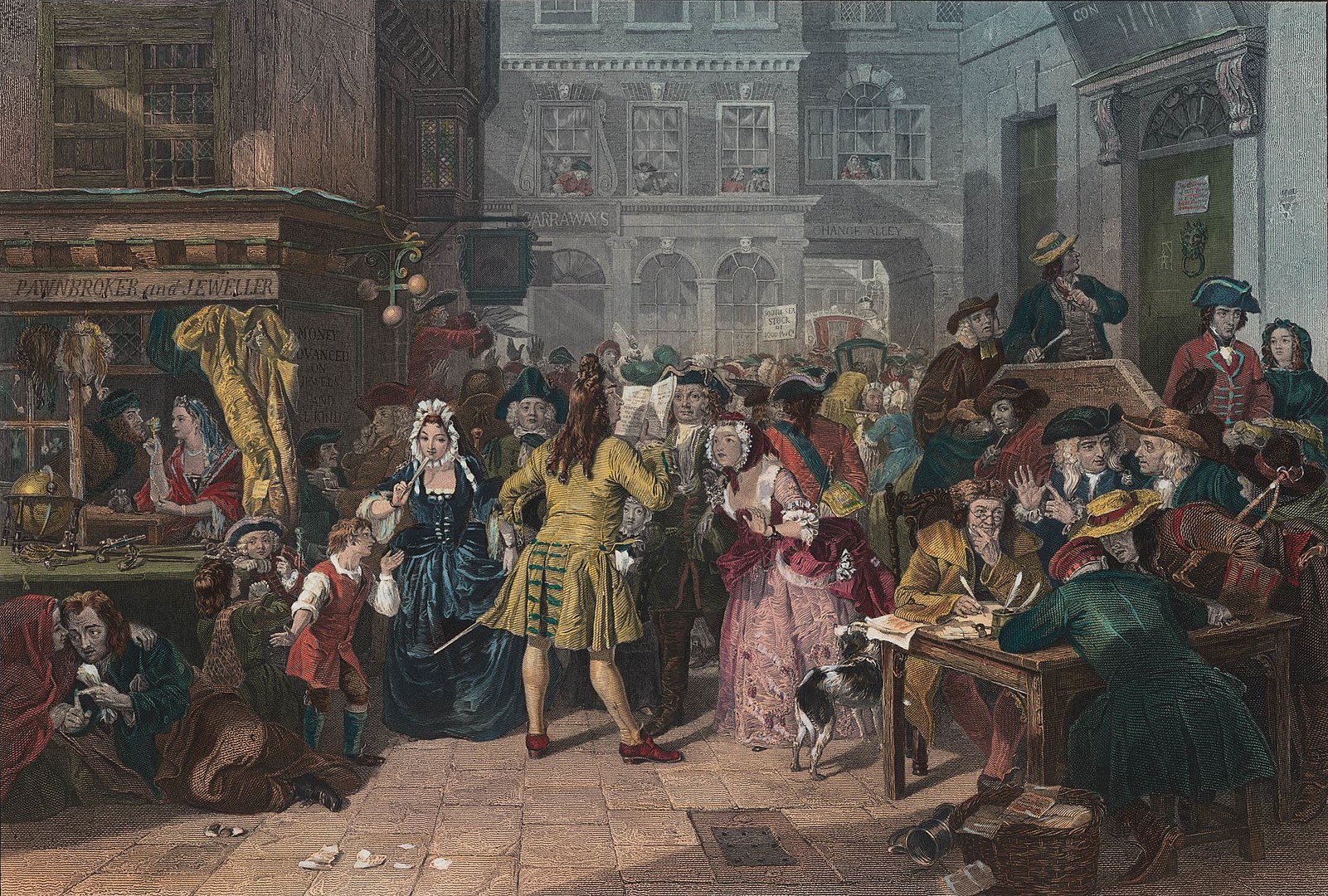
I learned this today. The South Sea Bubble was a financial bubble that sprang up around the share trading of the South Sea Company (SSC) in the early 18th century.
The South Sea Bubble wasn’t the first speculative bubble to happen. That honor goes to the Dutch Tulip Bubble of 1637. However, it was the first use of the word “bubble” in relation to a financial crisis. Before the South Sea “bubble”, speculative crises were known as manias. The South Sea Bubble was an extremely damaging bubble that was bad enough to make the government to change the law so that it couldn’t happen again.
The SSC was formed in 1711. It started with a sensible idea that went out of control. The idea was to consolidate the British national debt. Up until 1711, all departments borrowed money as and when they needed it. There was no central control, and nobody really knew how much debt there was. There was a huge amount of overspending. Robert Harley became Chancellor of the Exchequer in 1710 and the first job he gave himself was to sort out the debt situation. In early 1711 he managed to persuade the government to appoint a committee to look into the debt.
The investigation into the national debt calculated that the government owed £9 million to a whole range of different people and institutions. ( £9 million in 1711 is about £2.5 billion or $3.1 billion in 2022.) Robert Harley came up with a way to consolidate the debt, and that way was the South Sea Company.
It was formed in 1711 and every person or company that held government debt had to give it to the SSC. In return, they would receive the same value in shares. The government would pay a set amount to the company every year, 6% interest, and the SSC would distribute that to the shareholders as a dividend. A fairly ingenious way of paying back the national debt. It might have been ok if things had stopped there.
The government granted the SSC a monopoly to trade with South America. South America was owned mostly by Spain and Spain and the UK were at war in 1711. Everybody expected the war to end relatively soon and when it did, the SSC would earn a fortune trading with South America and shipping slaves from Africa. Things didn’t work out that well, though. When the war did end, in 1713, the SSC was only allowed to send in one shipload of slaves every year, and they were taxed heavily. The lucrative trade never appeared, and the company struggled to make any money.
In England, the shares in the SSC were becoming popular because it appeared that the government was going to keep to its word and pay back its debt. The dividends were guaranteed, and the government has always been a safe bet for investments. The original share price rose slightly, going over its initial £100 flotation price.
In 1718, Spain and the UK went to war again. The SSC’s assets in South America were seized and its profit dropped to almost zero. Confidence in the shares improved despite this and by £114 that year.
The government was overjoyed with this success. Their plan seemed to be working, so they arranged to pump the rest of the national debt (£30 million) into the SSC. The SSC decided to make a few friends and they gave stock options to a lot of government ministers, other important people, and the King’s mistress.
The new shares were announced in early 1720 and the SSC worked very hard to sell them. They stressed (lied) how successfully their trade missions to South America were. In 1720, news from South America would take months to arrive in the UK, so there was no way of checking up on what they said. And their claims started a speculating frenzy. By March 1720, the share price was at £330 and by the end of May it was at £550. There were rumors of a huge (£70 million) investment that the government was about to make in the SSC and this pushed prices even higher.
There were some suggestions that the share price was overvalued, but so many people in government were personally invested in the company that they did their best to keep pushing the price up. The higher it went, the more money they would make.
The share price peaked in August 1720 at £1000. There had been a frenzy of share buying around the country. Everyone that could invest did, and the price of other companies’ shares were also pushed up in the mayhem. And then, like all bubbles, the share price dropped. Within a month it was back down to its original £100.
A lot of people lost a lot of money. Other connected industries were harmed as well. The following investigations brought down a lot of influential government people. The scandals were huge. Robert Walpole, the new prime minister, managed to make his career by fixing the problem. He also saved the king and his mistress from any blame, which is perhaps not the most noble thing he did.
Isaac Newton owned shares in the South Sea Company. Nobody knows if he lost any money, but his famous quote, “I can calculate the movement of the stars, but not the madness of men,” came from the South Sea Bubble.
However, despite the anger, the South Sea Bubble was nowhere near as bad as other bubbles and there was no recession. It became hugely famous and synonymous with financial bubbles, but it wasn’t actually as terrible as it was made out to be. A lot of people received compensation and laws were changed to protect investors.
Interestingly, despite all of the problems it caused, the South Sea Company carried on. Its board were removed, punished, and replaced. The company carried on doing what it had been doing and kept selling shares in government debt all the way up to 1853 when it was disestablished. The government then worked out other systems to avoid paying back its debt. And this is what I learned today.
If you read this far, I would appreciate a like and a follow.
Picture By Edward Matthew Ward – http://www.library.hbs.edu/hc/historicalreturns/fb/slide3.html
Sources:
https://www.historic-uk.com/HistoryUK/HistoryofEngland/South-Sea-Bubble/
https://en.wikipedia.org/wiki/South_Sea_Company
https://www.rmg.co.uk/stories/topics/south-sea-bubble
https://blogs.loc.gov/inside_adams/2020/12/the-south-sea-bubble/
https://en.wikipedia.org/wiki/Tulip_mania
https://en.wikipedia.org/wiki/Economic_bubble

